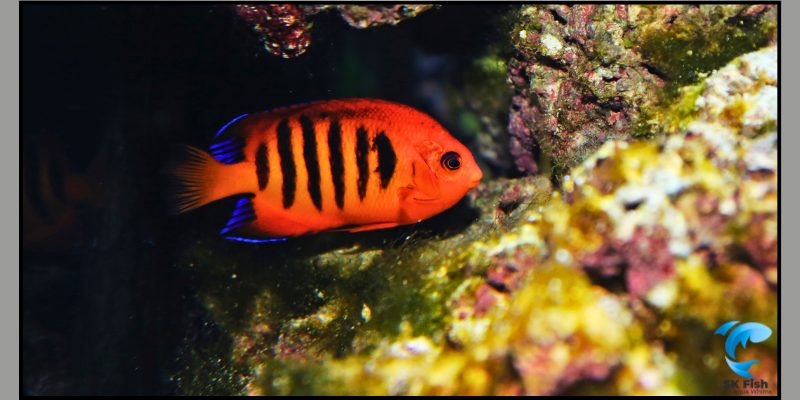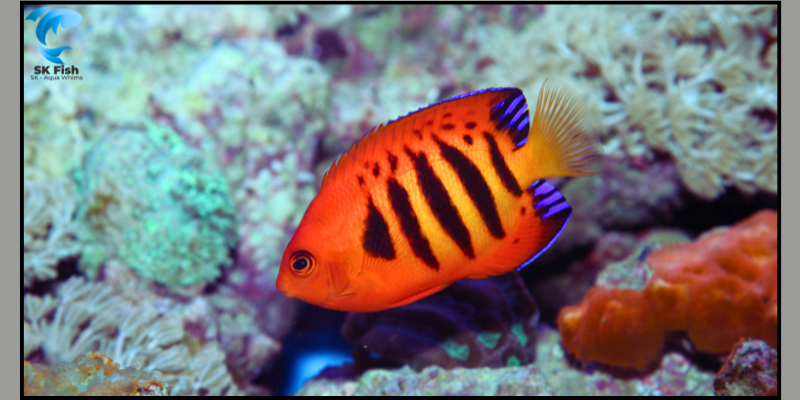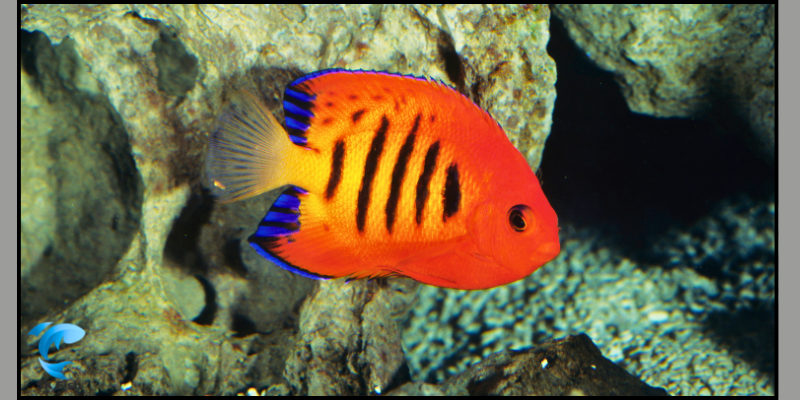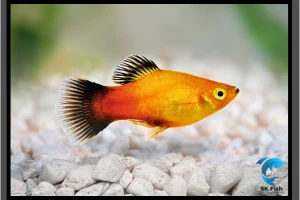Amazing Facts About Flaming Angelfish – Aquarium Care Guide
Published: 25 Feb 2024
Welcome, fellow enthusiasts, to the enchanting world of Flaming Angelfish. In this blog, we embark on a journey to explore the fascinating facts and care guide about these captivating creatures. Unveiling the secrets that make Flaming Angelfish a mesmerizing addition to your aquatic haven.
Are you curious about the care and intriguing facts surrounding Flaming Angelfish? Let’s delve into their aquatic life and caring tips, making your experience with angelfish truly extraordinary.
What is Flaming Angelfish?
The Flaming Angelfish is renowned for its vibrant red and orange colors adorned with vertical black stripes. Adding a flashy and gorgeous presence to your aquarium, this species belongs to the “Pomacanthidae” family.

Common Names
Flaming Angelfish are known by different names depending on the breeder. Common names include Flame Angelfish, Ember Angelfish, Scarlet Angelfish, Red Devil Angelfish, Flame Angel, Pygmy Angelfish, and Fireball Angelfish.
Weight and Size
The weight and size of Flaming fish are influenced by various factors, including proper care, water quality, diet, and more. Generally, Flame Angelfish reaches a length of 6 to 7 inches and weighs between 80 to 130 grams. It’s important to note that these are general figures, and with overall proper care, both the weight and size of the fish can potentially be increased.
Lifespan and Reproduction
The lifespan of Flame Angelfish is contingent on proper care, typically ranging from 7 to 10 years. This lifespan can be extended through attentive and appropriate care.
Regarding reproduction, the Flame Angelfish engages in a mating process where the female releases 1,000 to 1,400 eggs over 20 months. The production of eggs occurs in the presence of male angelfish, although they may consume the initial batch of eggs.
Following this, the male Flame Angelfish fertilizes the eggs, with an average hatching success rate of 75% to 80% occurring after a few days.
Aquarium Caring Tips for Flaming Angelfish
Curious about caring for Flaming Angelfish? Let’s delve into their unique care tips that will assist you in providing optimal care for these vibrant fish.
Tank Size
Tank size is crucial for the well-being and overall health of Flame Angel fish. The minimum required tank size for a pair of Flame Angelfish is 30 gallons. If you are considering multiple species or other tank mates for the Flaming Angelfish, the required size is 70 gallons, including live rocks and hiding places.
Tank Decor
Provide a comfortable environment for your beautiful buddy, which is essential for their health and longevity. When considering tank decor, you can use substrate to create a natural environment. Additionally, incorporate aquatic plants, floating plants, caves, and hiding places. Add natural elements such as smooth rocks and driftwood, as these elements contribute to the longevity of your buddy.
Water Conditions
Flaming fish are sensitive species that thrive in healthy and clean water conditions, typically found in warmer areas of the ocean. Maintaining the following water parameters is essential for their well-being:
- Temperature: 70 to 80 degrees Fahrenheit.
- pH: 6.7 to 7.4.
Given their sensitivity, regular testing for ammonia and nitrate levels is crucial, as these can be harmful. Water filtration plays a vital role in removing impurities, debris, and nitrogenous waste. Implementing regular water changes of approximately 20 to 25% of the tank volume every 1 to 2 weeks contributes to water quality.
Additionally, creating a natural habitat environment includes using air stones for gentle water movement, mimicking the slow water flow these species prefer. This setup enhances the overall well-being of the Flaming Angelfish.

Diet for Flaming Angelfish
A healthy and high-quality diet is crucial for the longevity of Flaming Angelfish. Their diet should include a variety of foods such as:
| Diet |
|---|
|
Maintain a feeding frequency of 2 or 3 times a day and avoid overfeeding to ensure optimal health for your angelfish.
Common Disease
Similar to other freshwater fishes, Flame Angelfish are susceptible to common diseases when their care and environment are not optimal. Some of these diseases include:
| Disease Names |
|---|
|
If you observe any of these diseases in your angelfish, it’s crucial to contact your aquarium specialist promptly for appropriate diagnosis and treatment. Early detection and intervention can contribute to the health and well-being of your aquatic companion.

Habitat and Distribution
The Flaming Angel is renowned for its beauty, with a total of 32 species found and distributed worldwide. They inhabit diverse locations such as coral reefs, shallow waters, and rocky substrates, typically preferring warm conditions at depths of up to 70 feet in the ocean.
Native to the Indo-Pacific region, Flaming Angelfish are widely distributed in the tropical waters of the Indian Ocean. Notably, they are also found in the Coral Triangle, encompassing regions like Indonesia, Malaysia, and the Philippines. This region is renowned for its biodiversity and serves as a crucial habitat for these captivating fish species.
Conclusion
This blog post comprehensively explores various aspects of Flaming Angelfish, including their different names, weights, sizes, lifespans, reproductive habits, care tips, tank decoration suggestions, dietary needs, common diseases, habitat, and distribution. We trust that this blog enhances your knowledge of caring for Flaming Angelfish and setting up an ideal tank. Feel free to share your feedback in the comments section.
FAQs
Is a Flame Angel reef safe?
Yes, the Flame Angelfish is generally considered reef-safe, but certain factors can influence their behavior. Proper care and effective tank management are recommended to ensure compatibility with specific corals.
Are Flame Angelfish rare?
The Flame Angelfish is not considered rare on a global scale. However, its rarity can vary based on factors such as seasonal demand, regional availability, and specific locations. In Hawaii, these species are deemed rarer due to their vibrant colors and popularity among aquarium enthusiasts.
What is the good name for angelfish?
Angelfish have different names such as:
- Blaze
- Tango
- Aurora
- Radiance
- Angel
- Diva
- Heaven
- Azura
- Rainbow
- Opal
- Ember
Are angelfish easy to take care of?
Yes, angelfish is easy to take care of. This species requires proper attention, including a well-balanced diet, maintaining water quality, and providing a natural environment.

SK Fish is your trusted source for practical fish care tips and delicious seafood recipes. Our team is dedicated to providing reliable, well-researched content for fishing enthusiasts and home cooks alike.

- Be Respectful
- Stay Relevant
- Stay Positive
- True Feedback
- Encourage Discussion
- Avoid Spamming
- No Fake News
- Don't Copy-Paste
- No Personal Attacks



- Be Respectful
- Stay Relevant
- Stay Positive
- True Feedback
- Encourage Discussion
- Avoid Spamming
- No Fake News
- Don't Copy-Paste
- No Personal Attacks


![Discover the Truth: How Long Does It Take for Guppies to Breed? [Expert Tips Inside]](https://skfish.com/wp-content/uploads/guppy-how-to-breed-200x133.webp)
![The 7 Best Freshwater Fish for Low Light Tanks [Hassle-Free Setup and Maintenance]](https://skfish.com/wp-content/uploads/best-freshwater-fish-for-low-light-tanks-200x133.webp)
![How to Set Up a Freshwater Fish Tank in 5 Easy Steps [No Experience Needed, Avoid Common Pitfalls]](https://skfish.com/wp-content/uploads/how-to-set-up-a-freshwater-fish-tank-in-5-easy-steps-200x133.webp)
